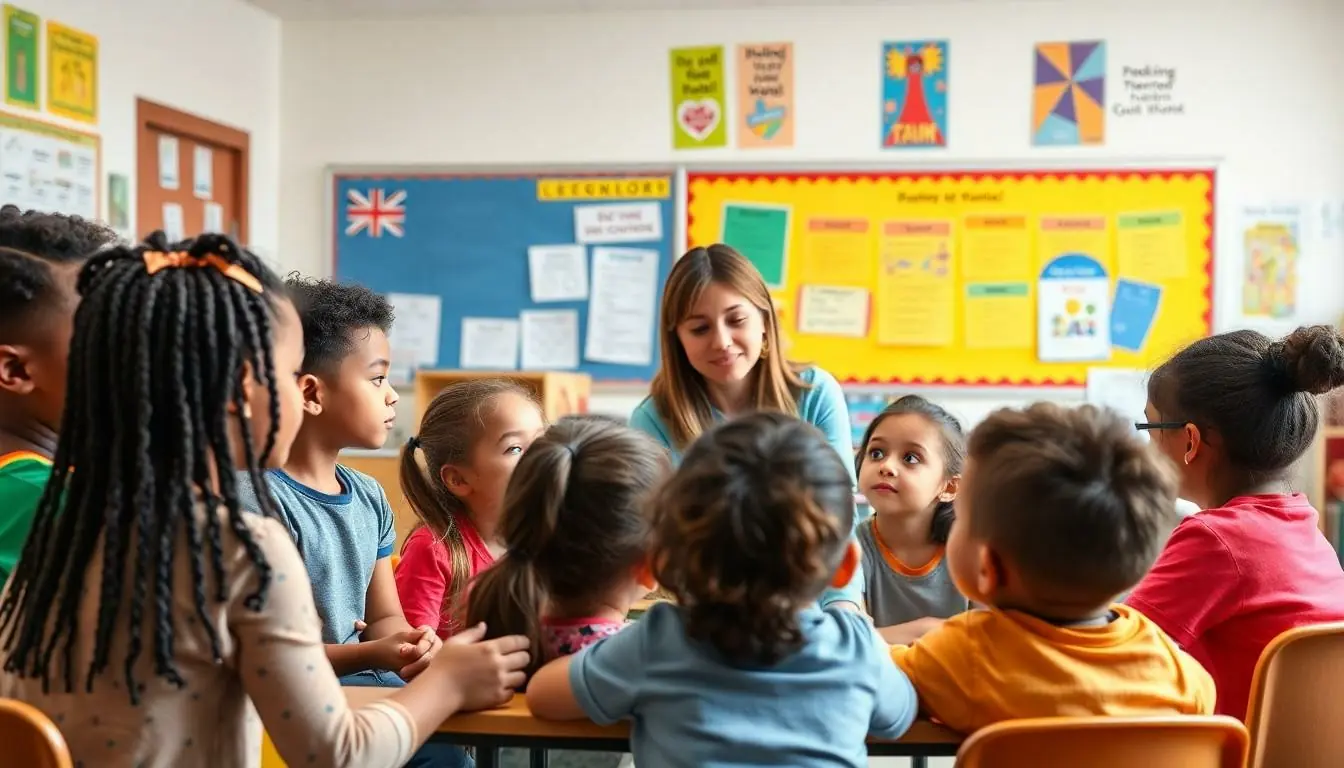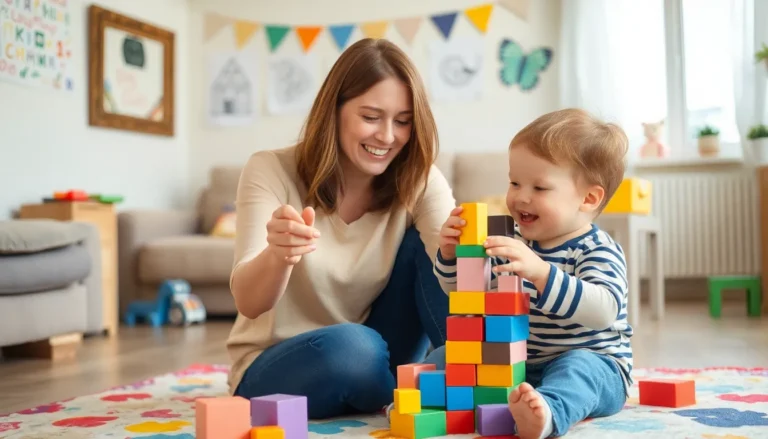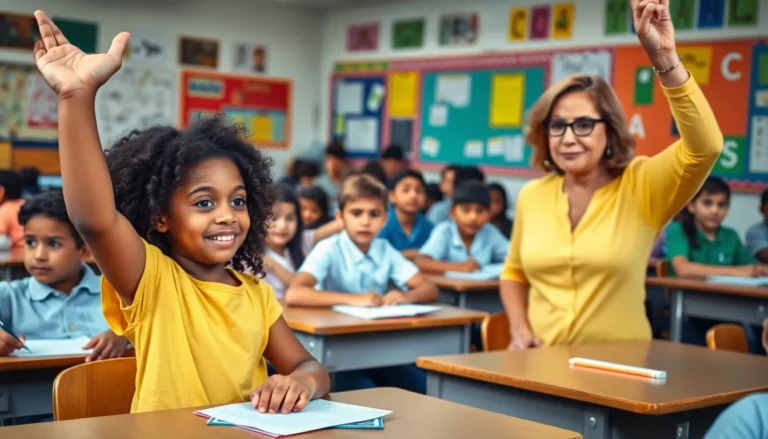Table of Contents
ToggleWhen kids start throwing punches instead of playing nice, it can leave parents feeling like they’re stuck in a never-ending episode of a reality show. Fighting at school isn’t just a phase; it’s a signal that something needs to change. The challenge lies in figuring out how to discipline a child without turning the situation into a wrestling match of its own.
Understanding the Issue of Fighting at School
Fighting at school reflects deeper issues beyond childish behavior. A child’s actions can signal the need for intervention and support.
Common Reasons Children Fight
Children often fight for various reasons. Some battles stem from unresolved conflicts with peers. Competition for attention or resources can also provoke aggression. Bullying plays a significant role, as victims may retaliate when feeling cornered. Emotional responses to stress, such as frustration or fear, might trigger fights as well. Lastly, a child’s environment, including familial dynamics, influences their behavior at school. Understanding these motivations is crucial for addressing the root causes.
Signs That Your Child May Be Involved
Identifying signs of involvement in fighting is essential. Changes in behavior often indicate a problem. Frequent mentions of fights or peers fighting can raise red flags. A child may also show signs of fear, avoiding certain areas of school or withdrawing from friends. Physical signs, such as unexplained bruises or injuries, might suggest involvement in altercations. Monitoring changes in academic performance may reveal distractions stemming from conflicts too. Observing these indicators helps parents take timely action.
Effective Discipline Strategies
Discipline involves structured approaches to guidance. Employing clear strategies can significantly impact a child’s behavior.
Setting Clear Rules and Expectations
Establishing clear rules helps children understand boundaries. Create specific and concise guidelines around acceptable behavior at school. Communicate these expectations regularly to reinforce their importance. Consistency plays a crucial role; children benefit from knowing the consequences of their actions. Involve children in the rule-setting process, as this encourages ownership. Encourage discussion about why certain behaviors are unacceptable. This dialogue promotes understanding and accountability.
Implementing Consequences for Fighting
Implementing appropriate consequences discourages fighting. Ensure that consequences directly relate to the behavior, providing clarity. Consistency in applying these consequences is vital for effectiveness. Use a calm and measured approach when addressing incidents. For serious offenses, consider temporary removal from a situation or privilege. Encourage reflection after the incident, allowing children to understand the impact of their actions. Emphasizing the importance of problem-solving skills can also guide children toward more constructive alternatives.
Teaching Conflict Resolution Skills
Teaching conflict resolution skills equips children to navigate disagreements peacefully. These skills foster emotional intelligence and help avoid physical confrontations.
Encouraging Communication
Encouraging open dialogue forms the foundation of resolving conflicts. Parents can guide their children to express feelings and thoughts without resorting to violence. Active listening plays a crucial role; it involves acknowledging each child’s perspective. Simple prompts can facilitate discussions, such as asking, “How did that make you feel?” or “What could you do differently next time?” Reinforcing the importance of respectful communication builds healthy relationships with peers. Recognizing and validating emotions helps children understand their own feelings and those of others. Effective communication reduces misunderstandings and lays a pathway for peaceful resolutions.
Role-Playing Scenarios
Role-playing scenarios provide practical experiences for conflict resolution. Children can practice responses to challenging situations in a safe environment. Creating realistic situations mirrors school-related conflicts, such as sharing toys or responding to teasing. Assigning roles allows them to explore various perspectives, deepening empathy. Discussing outcomes after each role-play session enhances critical thinking. Establishing ground rules ensures each child’s comfort during these practices. Role-playing empowers children to develop problem-solving skills and fosters confidence in real-life interactions. This approach not only diminishes fighting but also strengthens their social capabilities.
Involving the School and Educators
Involving the school and educators is crucial in addressing a child’s fighting behavior. Collaboration between parents and teachers can provide a comprehensive approach to resolving the issue.
Collaborating with Teachers
Building a relationship with teachers is essential. Teachers often observe children’s interactions in various settings and can provide valuable insights. Regular communication about behavioral changes or incidents fosters a shared understanding of the child’s needs. Parents should set up meetings to discuss specific incidents and explore strategies together. Sharing expectations between home and school creates consistency, which reinforces positive behavior. Striking a partnership allows for collective problem-solving efforts, ensuring that both the home and school environments support the child’s development.
Utilizing School Resources
Schools typically offer various resources for conflict resolution and behavioral support. Counseling services often assist in addressing underlying emotional issues linked to fighting. Participating in workshops or programs focused on conflict resolution equips children with necessary skills. Many schools implement peer mediation programs that enable students to resolve disputes cooperatively. These resources can enhance a child’s ability to manage conflicts independently. Leveraging available tools promotes a unified approach that bridges home and school, creating a conducive environment for behavioral improvement.
Conclusion
Addressing a child’s fighting behavior at school requires a thoughtful and proactive approach. By understanding the underlying issues and implementing effective discipline strategies parents can guide their children toward healthier conflict resolution methods. Setting clear expectations and involving children in the process fosters accountability and ownership of their actions.
Encouraging open communication and teaching emotional intelligence are vital components in preventing future conflicts. Collaborating with educators and utilizing school resources can create a supportive environment for behavioral improvement. With consistent effort and understanding parents can help their children navigate challenges and develop the skills necessary for peaceful interactions.








